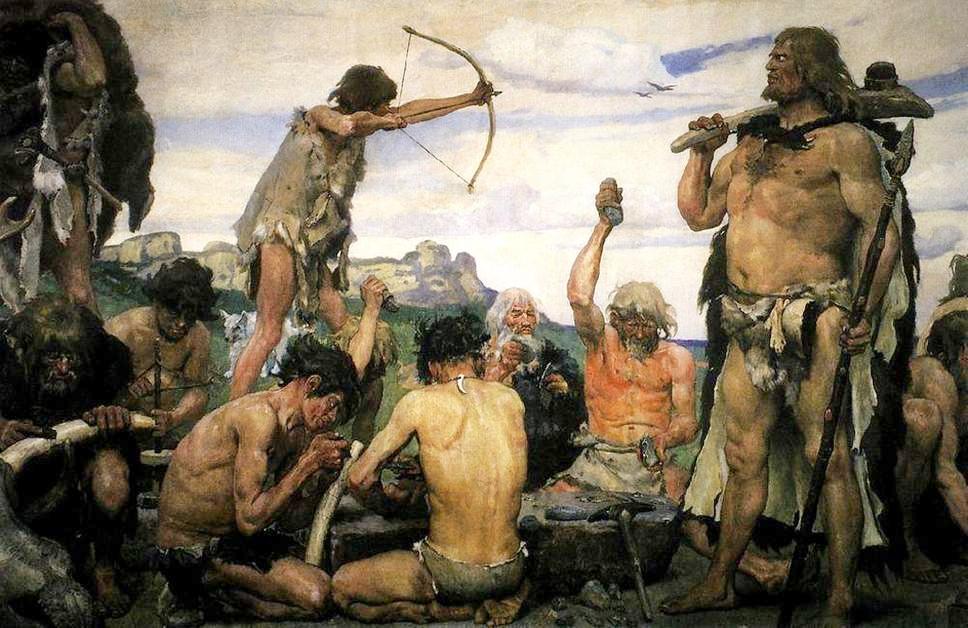
Stone Age Eras: The Mesolithic

Figure 1.--Here is an artist's depiction of people in tbe Mesolithic era or Mid-Stone Age, a elatively short poeriod marking the transirtion from the Paleolithic to the Neolithic era. Note the bow and arrow this is an important hunting technology because it permitted kills ast a safe ditance. It is believe to have appeared right at the transition from Paeolitic to the Mesolitic, one of several examples of the quicking technological change associted with the develoment of antanomically modern humans (AMH). This seems a reasonably accurate depiction. The only era we note is that is very bunlikely that hunter would have waisted an srriw on a bird in flight. Artist: Viktor Vasnetsov.
|
|
The Mesolithic or Middle Stone Age is a relatively recent term. Other terms have been used. The term represents the need felt by archeologists to better describe the transition from the Paleolithic to the Neolithic (late-stone age). The chronological dates for the Mesolithic vary regionally. Anatomically modern man (AMH) occurred at the very end of the Paleothic Era, especially the post-glacial/gracile subtypes, meaning smaller and more fine-boned skeleton beginning (50,000–30,000 BP). [Hawks, et. al.] This means that in ghe Mesolithic we are talking about AMH. And we see technologically change at a much faster pace. During this period ground stone tools appeared they were much more finely fashioned than those used in the Paleolithic. The tools were commonly used for cutting and smoothing. Some may have been used for ornamentation. The people involved were still huntergathers. They still simplly collected food. without modifying the food they found or the environment in which they found it. Hunting habits might change from targetting large game to small game which was often more plentiful. A major technological change affecting hunting was the appearance of the bow and arrow. This allowed kills at a safe distance. And it occurred right at the transition between from the late-Paleolithic to the Mesolithic. It was also available locally, this less nomadic food strategy that probably played a role in the development of agriculture. People began asking inreasing adaptations to localized territories and gradually improved the efficiency with which they utilized the resources available to them. They by now knew where and when resources were available. There are increasingly complex devices including traps, nets, fishhooks built from composite pieces and materials. Small tools were used to make other other more complex tools. There is evidence of small villages where people lived at least part of the year. There were major climatic changes. It was during the Mesolithic that the Ice Age ended (about 8,000 B.C.). The mass extinction of the Pleistocene mega-fauna occurred at this time. Giant mammals like mammoths, mastodons, giant bison, and ground sloths disappeared. This was a factor in shifting hunting strategies to smaller game like antellope and gazelles. Various stratergies were developed to hunt these faster more evasive prey. This included driving the prey toward nets and cliffs.
Sources
Hawks, J., E.T. Wang, G.M. Cochran, H.C. Harpending, and R.K. Moyzis. (2007). "Recent acceleration of human adaptive evolution". Proceedings of the National Academy of Sciences Vol. 104, No. 52 (2007), pp. 20753–58.
CIH

Navigate the Children in History Website:
[Return to the Main Stone Age era page]
[Return to the Main Stone Age page]
[Return to the Main Chronology page]
[About Us]
[Introduction]
[Biographies]
[Chronology]
[Climatology]
[Clothing]
[Disease and Health]
[Economics]
[Freedom]
[Geography]
[History]
[Human Nature]
[Law]
[Nationalism]
[Presidents]
[Religion]
[Royalty]
[Science]
[Social Class]
[Bibliographies]
[Contributions]
[FAQs]
[Glossaries]
[Images]
[Links]
[Registration]
[Tools]
[Children in History Home]
Created: 2:10 PM 9/5/2018
Last updated: 2:10 PM 9/5/2018



